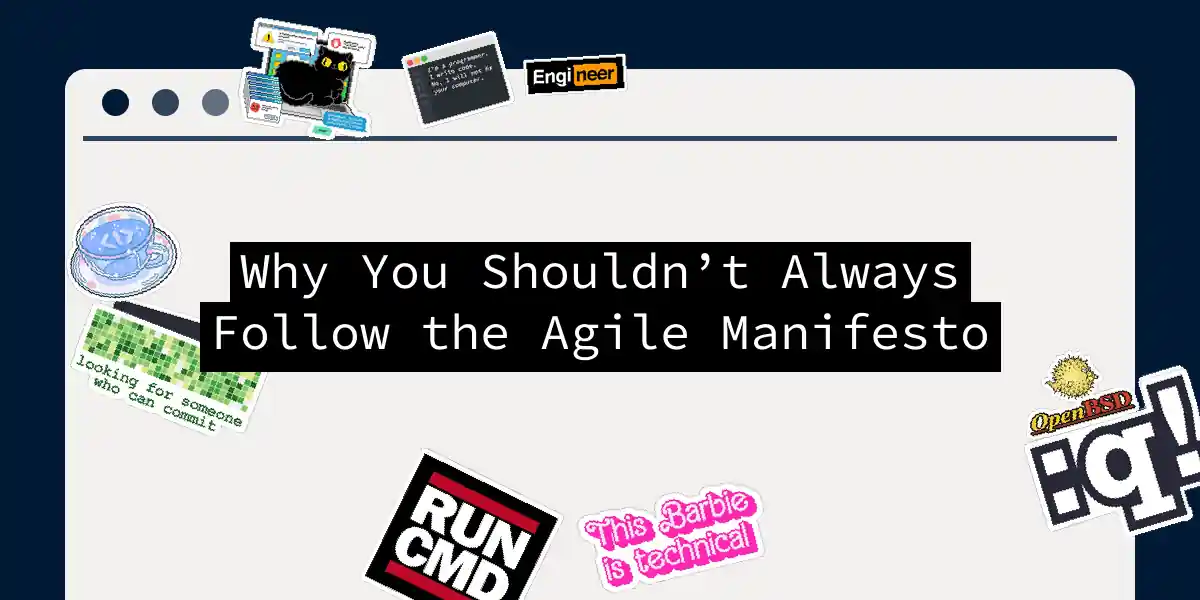The Agile Conundrum: When Following the Manifesto Isn’t Enough
In the world of software development, the Agile Manifesto has been hailed as a revolutionary guide for teams seeking to deliver software quickly and adapt to change. However, as with any methodology, the reality often diverges from the ideal. Here’s why blindly following the Agile Manifesto might not always be the best approach.
The Misinterpretation of Agile
One of the most significant issues with Agile is its misinterpretation. Many organizations adopt Agile practices without truly understanding its core values and principles. This leads to a hybrid of Agile and traditional waterfall methods, often resulting in the worst of both worlds. For instance, teams might retain all the meetings from waterfall methodologies while adding Agile ceremonies like scrums and standups, only to neglect essential aspects like requirements and QA.
The Corporate Conundrum
Agile works best in small, agile teams (no pun intended) and startups, where there is less corporate overhead. However, in large corporations, the rigid structures and bureaucratic red tape can make it nearly impossible to implement Agile effectively. As one Agile Manifesto co-author pointed out, you can’t turn an oil tanker into a jetski overnight.
Faux-Agile: The Reality on the Ground
The term “Agile” has been so diluted that it often becomes meaningless. Many organizations claim to be Agile but end up practicing a watered-down version that ignores the original values and principles. This “faux-Agile” approach can lead to projects that are more chaotic than controlled, with changing requirements, extended deadlines, and ballooning budgets.
The Spotify Model Trap
The Spotify Model, often cited as an example of successful Agile implementation, is actually a cautionary tale. Despite its popularity, the model did not work as intended even at Spotify. Yet, many organizations blindly adopt it, hoping to replicate the success without understanding the unique context and challenges that made it fail.
Developer Discontent
Developers are often the ones who bear the brunt of poorly implemented Agile methodologies. Increased interference, higher pressure, and demands to “go faster” can lead to burnout and a decrease in overall productivity. Ron Jeffries, one of the original signatories of the Agile Manifesto, has even suggested that developers should abandon Agile methods altogether and focus on the underlying principles that support good software development.
The Heart of Agile: Principles Over Processes
The core issue with Agile is not the methodology itself but how it is applied. The Agile Manifesto emphasizes values such as individuals and interactions over processes and tools, and responding to change over following a plan. However, in practice, many organizations prioritize the processes and ceremonies over the people and the adaptability.
Practical Steps to True Agility
So, how can you avoid the pitfalls of faux-Agile and truly benefit from the Agile methodology?
1. Understand the Core Values
Before implementing Agile, ensure that your team and management understand and align with the core values of the Agile Manifesto. This includes valuing individuals and interactions, working software, customer collaboration, and responding to change.
2. Keep it Simple
Avoid overcomplicating your Agile process. Focus on the essential practices that deliver value, such as iterative development, continuous integration, and regular feedback loops.
3. Trust Your Team
Agile thrives on trust and autonomy. Give your team the environment and support they need, and trust them to get the job done. Micromanaging and dictating every step can strangle the very spirit of Agile.
4. Iterate and Adapt
Agile is about being adaptable. Be willing to change your approach based on what you learn. This might mean adjusting your development process, tools, or even the scope of the project.
Conclusion
The Agile Manifesto is a powerful tool for software development, but it is not a one-size-fits-all solution. By understanding its core values, keeping the process simple, trusting your team, and being adaptable, you can avoid the common pitfalls of faux-Agile and truly benefit from the methodology.
In the end, it’s not about following the Agile Manifesto to the letter; it’s about embracing the principles that make Agile work. So, the next time you’re tempted to say “we’re Agile,” ask yourself: are you truly living the Agile values, or are you just going through the motions? The difference could be the success or failure of your project.
